Bhutan, Nepal & the Mystical Himalayas
October 5-27, 2011
BHUTAN - October 7-13, 2011
Page One - Getting to Bhutan and Tiger's Nest Monastery - Paro, Bhutan
Brief Overview of the History of Bhutan
Bhutan's early history is obscure. It may have been inhabited as early as 2000 BC, but not much was known until the introduction of Tibetan Buddhism in the 9th century, when many monks in Tibet fleed to Bhutan. In the 12th century, the Drukpa Kagupa school was established and remains the dominant form of Buddhism in Bhutan today. The country's political history is intimately tied to its religious history. Bhutan is one of the only countries which has never been conquered, occupied, or governed by an outside power. Although there has been speculation that it was under the Tibetan Empire in the 7th to 9th centuries, firm evidence is lacking. The consolidation of Bhutan occurred in 1616 when a Lama from western Tibet, Shabdrung Ngawang Namgyel, defeated three Tibetan invasions, subjugated rival religious schools, and established himself as ruler over a system of ecclesiastical and civil administrators. He established a state clergy under a religious leader, the Chief Abbot, and a political system administered by monks at whose head he placed a chief, the Desi. After his death, infighting and civil war was common for the next 200 years until in 1885, Ugyen Wangchuck was able to consolidate power and cultivated closer ties with the British in India. In 1907, Ugyen Wangchuck was elected as the hereditary ruler of Bhutan and installed as the head of state Druk Gyalpo (Dragon King), the beginning of the Wangchuck monarchy. When Ugyen Wangchuck died in 1926, his son Jigme became the next ruler, and when India gained independence in 1947, the new Indian Government recognized Bhutan as an independent country. In 1949, India and Bhutan signed the Treaty of Peace and Friendship, which provided that India would not interfere in Bhutan's internal affairs but Bhutan would be guided by India in its foreign policy. Succeeded in 1952 by his son Jigme Dorji Wangchuck, Bhutan began to slowly emerge from its isolation and began a program of planned development. Bhutan became a member of the U.N. in 1971. In 1972, Jigme Singye Wangchuck ascended the throne at age 16. He emphasized modern education, decentralization of governance, the development of hydroelectricity and tourism and improvements in rural developments. He was perhaps best known internationally for his development philosophy of "gross national happiness." It recognizes that there are many dimensions to development and that economic goals alone are not sufficient. Satisfied with Bhutan's transitioning democratization process, he abdicated in December 2006 rather than wait until the promulgation of the new constitution in 2008. His son, Jigme Khesar Namgyel Wangchuck became King upon his abdication. In March 2005, the king and government distributed a draft of the country's first constitution, requesting that every citizen review it. On July 18, 2008, the parliament formally adopted the constitution, marking the final step in Bhutan's historic transition from absolute monarchy to parliamentary democracy.
A new house of parliament, the National Council, was chartered consisting of 20 elected representatives from each of the dzonghags (districts), and 5 persons selected by the King. The National Council was paired with the other already existing house, the National Assembly.The National Council is the upper house of Bhutan's relatively new Parliament, which also comprises the Druk Gyalpo (Dragon King), and the National Assembly. It is the subordinate house, and cannot author monetary or budget-related bills. Besides creating and reviewing legislation, the National Council acts as the house of review on matters affecting the security, sovereignty, or interests of Bhutan that need to be brought to the notice of the Druk Gyalpo, the Prime Minister and the National Assembly. The current National Assembly has 47 members, who were elected in the first ever general elections on March 24, 2008. Per the Constitution, the monarchy is given a leadership role in setting the direction for the government as long as the King shall demonstrate his commitment and ability to safeguard the interests of the kingdom and its people. The position of Chief Abbot still exists (religious leader), and the Chief Abbot is a key advisor to the King.
The people of Bhutan can be divided into three broad ethnic categories--Ngalops, Sharchops, and Lhotsampas. The Ngalops make up the majority of the population, living mostly in the western and central areas. The Ngalops are thought to be of Tibetan origin, arriving in Bhutan during the 8th and 9th centuries A.D. and bringing Buddhism with them. Most Ngalops follow the Drukpa Kagyupa discipline of Mahayana Buddhism. The Ngalops predominate in the government, and the civil service and their cultural norms have been declared by the monarchy to be the standard for all citizens.
The Sharchops, who live in the eastern section of Bhutan, are considered to be descendants of the earliest major group to inhabit Bhutan. Most follow the Ningmapa discipline of Mahayana Buddhism. Sharchop is translated as "people of the east." The Ngalops, Sharchops, and the indigenous tribal people are collectively known as Drukpas and account for about 65% of the population. The national language is Dzongkha, but English is the language of instruction in schools and an official working language for the government.
The Lhotsampas are people of Nepali descent, currently making up 35% of the population. They came to Bhutan in the 19th and 20th centuries, mostly settling in the southern foothills to work as farmers. They speak a variety of Nepali dialects and are predominantly Hindu.
In 1988, due in part to the dominant population's concern of increasing influence and numbers of the predominantly Hindu Lhotsampas, Bhutan was reported to have evicted some number of Nepali-speaking residents (Bhutanese reports say about 5,000 and Refugee reports say over 100,000) from districts in southern Bhutan and many fled due to persecution, creating a large refugee community that is now being detained in seven temporary United Nations refugee camps in Nepal and Sikkim. The actual numbers are difficult to establish. It also appears that people have infiltrated these camps that are not from Bhutan. After years of negotiations between Nepal and Bhutan, in 2000 Bhutan agreed in principle to allow certain classes of the refugees to return to Bhutan. However the situation is at a standstill, after violence was committed on Bhutanese officials by some of people in the camps.Significant unrest is now reported to be fermenting in the camps, especially as the United Nations terminates a number of educational and welfare programs in an effort to force Bhutan and Nepal to come to terms. As the Bhutanese government was unwilling to take them into their country and Nepal doesn't want them, many developed nations offered the Refugees to settle in their own countries, including the U.S. and Australia. As many as 20,000 Bhutanese refugees have been resettled in other countries. With less than 700,000 people living in Bhutan, if all the Bhutanese refugees in Nepal would return it would severely disrupt the country's demography, as noted below.
This unresolved issue remains a critical problem for Bhutan. The ethnic exodus followed the implementation of Bhutan’s Citizenship Act of 1985 and the subsequent nation-wide Census of 1988, which resulted in revoking or questioning of citizenship of many Lhotsampas. The Bhutan Government has tended to resist repatriation because most of the refugees are of Nepali origin, and this is seen as creating a 'demographic imbalance' in some areas of the thinly-populated country, as well as a threat to the existing Government. While growing international pressure has forced Bhutan to accept the idea of repatriation of some refugees, non-Bhutanese and Bhutanese with criminal and subversive records will certainly be excluded, accounting for a sizeable and potentially volatile chunk of the refugee population. Bhutan also fears with some justification that the repatriated groups may be infected by the Nepalese Maoists. The Bhutanese Home Secretary, Dasho Penden Wangchuk, stated on September 23, 2006, that the growing nexus between people in the camps in eastern Nepal, the Maoists and Indian Left Wing Extremists would have far-reaching impact on the region’s security.
Bhutan has long maintained a policy of strict isolationism, both culturally and economically, with the goal of preserving its cultural heritage and independence. Only in the last decades of the 20th century were foreigners allowed to visit the country, and only then in limited numbers. In this way, Bhutan has preserved many aspects of a culture which dates directly back to the mid-17th century.
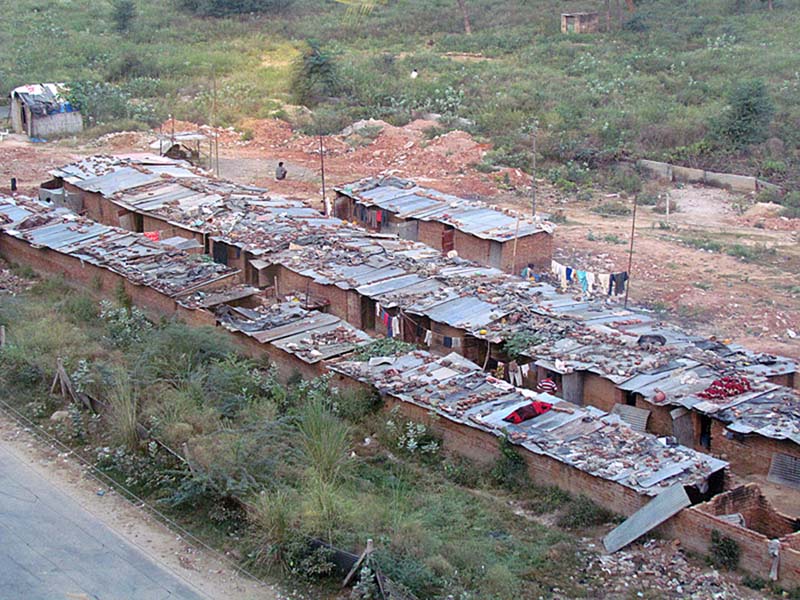
I took a nonstop flight from New York JFK Airport to Indira Gandhi International Airport in Delhi, India where the entire Overseas
Adventure Travel tour group met at Hotel Ibis Gurgaon in Gurgaon, one of the several major contiguous cities in that area. We stayed
overnight at this hotel before flying to Paro, Bhutan the next morning.
From my hotel room, I looked down on this view that looked like
a scene straight out of the movie "Slumdog Millionnaire." Poverty stricken people are living in these shacks, sharing rudimentary bathing
and toilet facilities. The 2 red blankets that you can see on the top of the metal roofs are covering people who are sleeping under them.
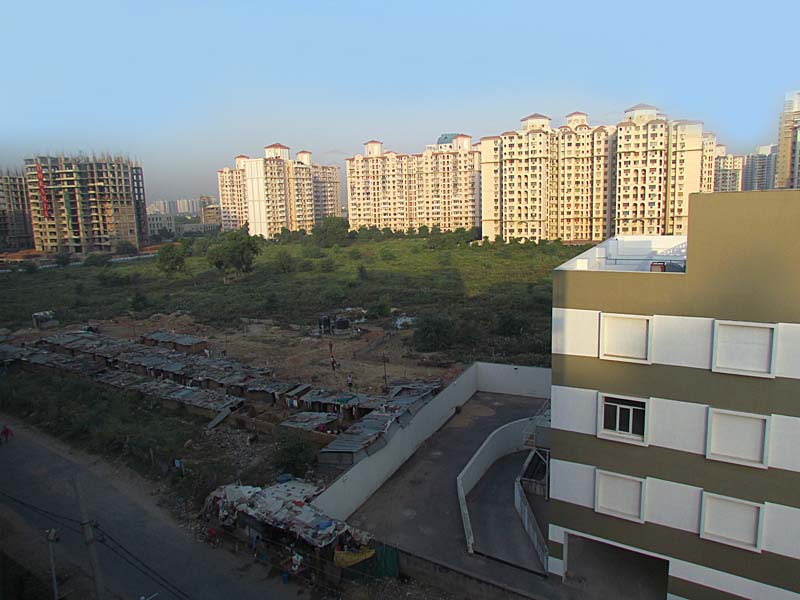
Gargaon is the call center headquarters of India. You have probably talked to someone who is living in Gargaon, when you have called for
help from one of the companies you do business with. You can see tall apartment buildings in the background, where many call center workers live
with the very poor people living in the field in the foreground.
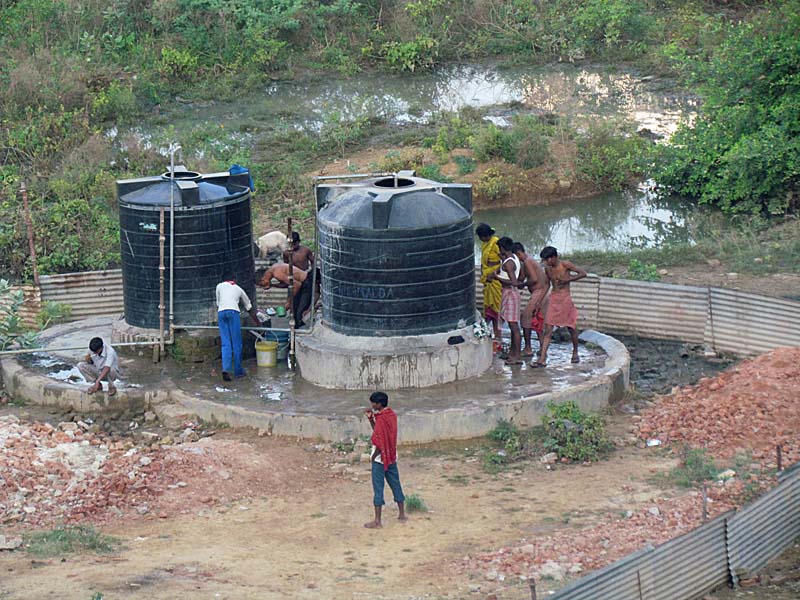
People from the slum community washing themselves. This was the morning after our arrival in India - another view from my hotel room.
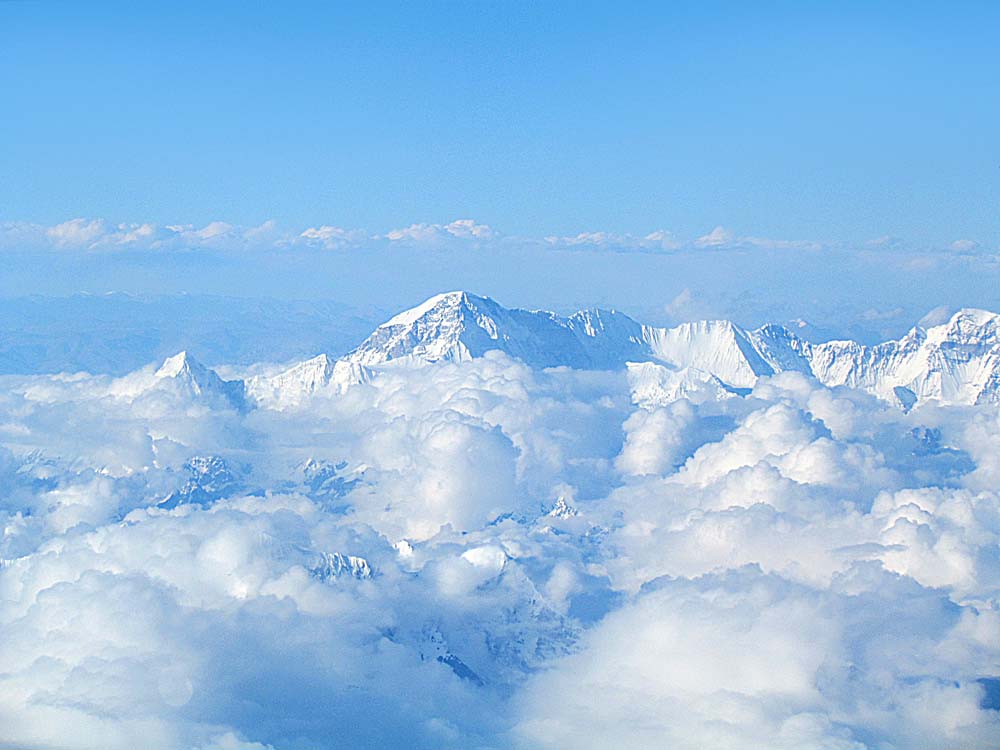
The morning of October 7 we flew from India to Paro, Bhutan after waiting 3 1/2 hours for the plane to take off. Delays/cancellations are common for flights to Bhutan.
Suddenly, after we rose above the clouds, we started to see the Himalayan Mountains.
The Himalayan mountain system is the world's highest, and home to the world's highest peaks, including Mount Everest.
To comprehend the enormous scale of this mountain range, consider that Aconcagua in the Andes, at 22,841 feet, is the highest peak outside Asia,
whereas the Himalayan system includes over 100 mountains exceeding 23,600 feet.The main Himalayan range runs west to east,
from the Indus river valley to the Brahmaputra river valley, forming an arc 1,500 miles long. Some of the world's major river systems arise in the Himalayas,
and their combined drainage basin is home to some 3 billion people (almost half of Earth's population) in 18 countries.
Many Himalayan peaks are sacred in Hinduism and Buddhism.
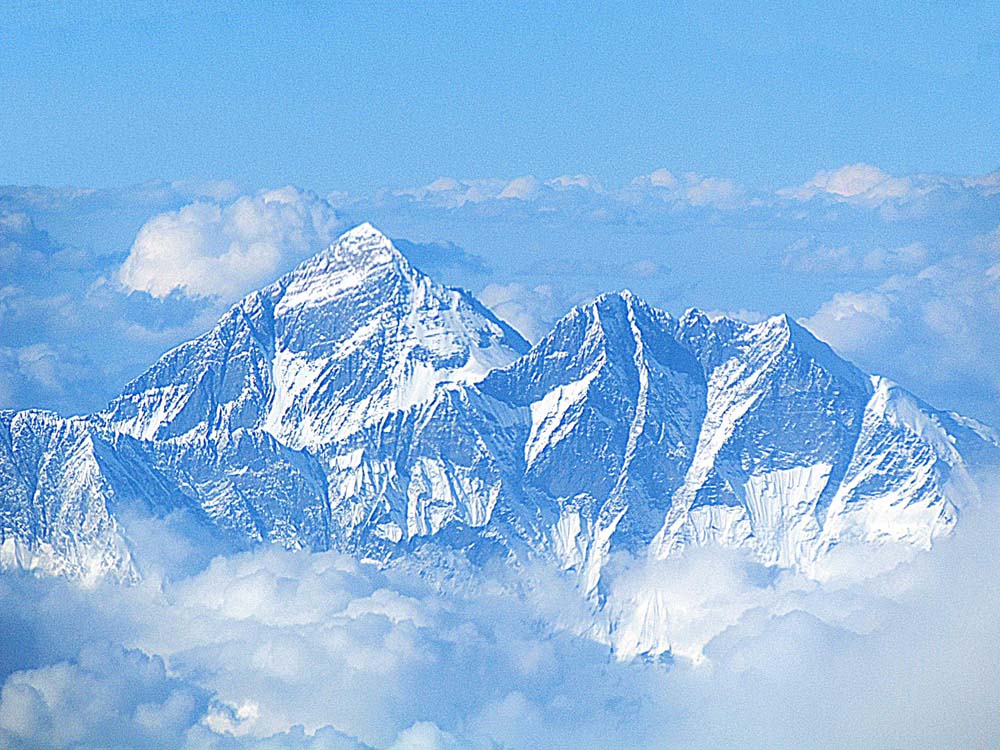
Soon we saw what we were waiting for, Mount Everest, shown here behind Lhotse on the right and Nuptse on the left.
Mount Everest is the tallest mountain in the world.
It is 29,029 feet high (more than twice as high as any fourteener in Colorado).
It was named after a British surveyer. In Nepal, its name is Sagarmatha. The Tibetan name
is Chomolungma. Lhotse is 8516 meters or 27,939.63 feet high, and Nuptse is
7855 meters or 25,771 feet high.
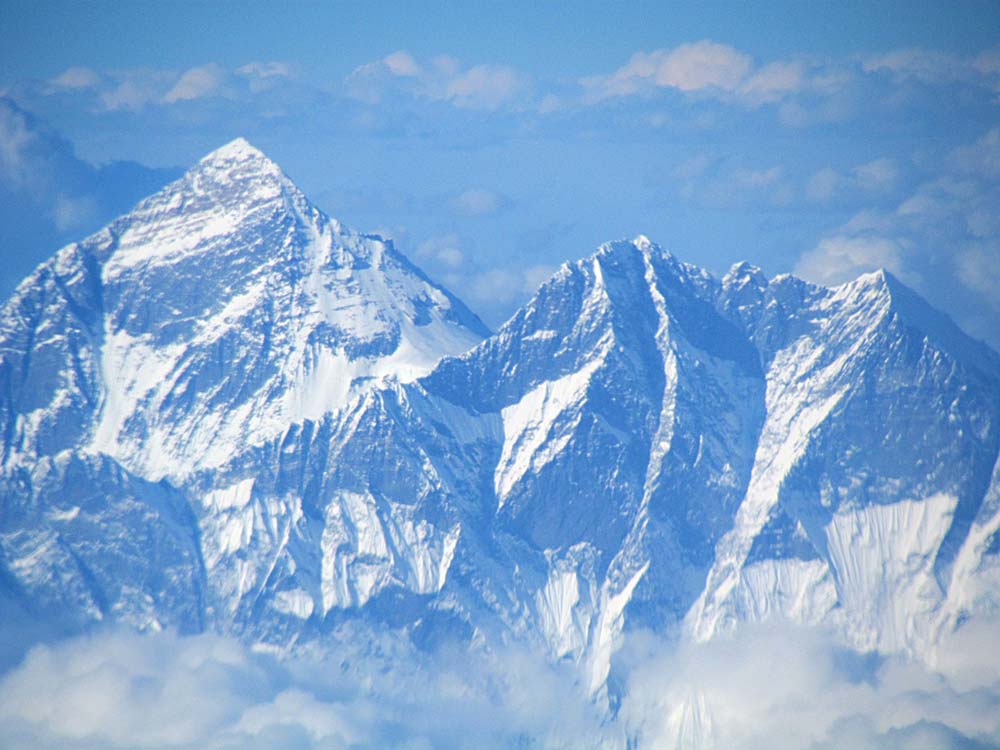
The snow field behind Lhotse on the right side of the Mt. Everest peak is the South Col. On the South Col, climbers enter the death zone.
Climbers typically only have a maximum of two or three days they can endure at this altitude for making summit bids.
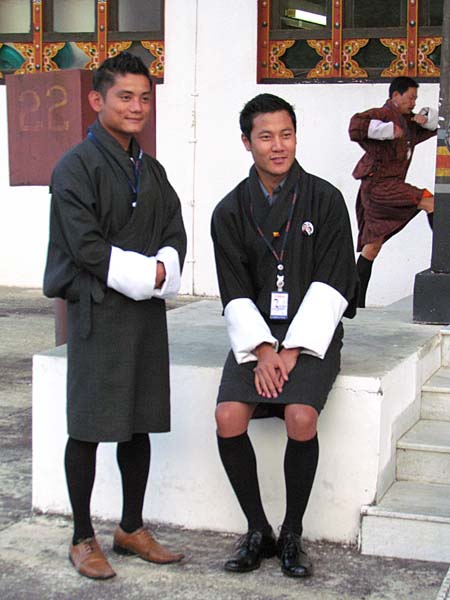
Meeting us at the Paro International Airport in Bhutan was our guide, Tsering,
shown on the right. He is wearing the gho,
the national dress for men in Bhutan. All Bhutanese citizens are required to observe the national dress code while in public during daylight hours.
The rule is enforced more rigorously in some districts (dzongkhag) than others.
Men wear a heavy knee-length robe tied with a belt,
folded in such a way to form a pocket in front of the stomach. Women wear colorful blouses over which they fold
and clasp a large rectangular cloth called a kira, thereby creating an ankle-length dress. A short silk jacket may be worn over the kira.
Everyday gho and kira are cotton or wool, according to the season, patterned in simple checks and stripes in earth tones.
For special occasions and festivals, colorfully patterned silk kira and, more rarely gho may be worn.
Additional rules of protocol apply when visiting a dzong (fortress) or a temple, or when appearing before a high-level official.
Male commoners wear a white sash from left shoulder to opposite hip. Women wear a narrow embroidered cloth draped over the left shoulder.
The dress code has met with some resistance from the ethnic Nepalese origin citizens living along the Indian border
who resent having to wear a cultural dress which is not their own.
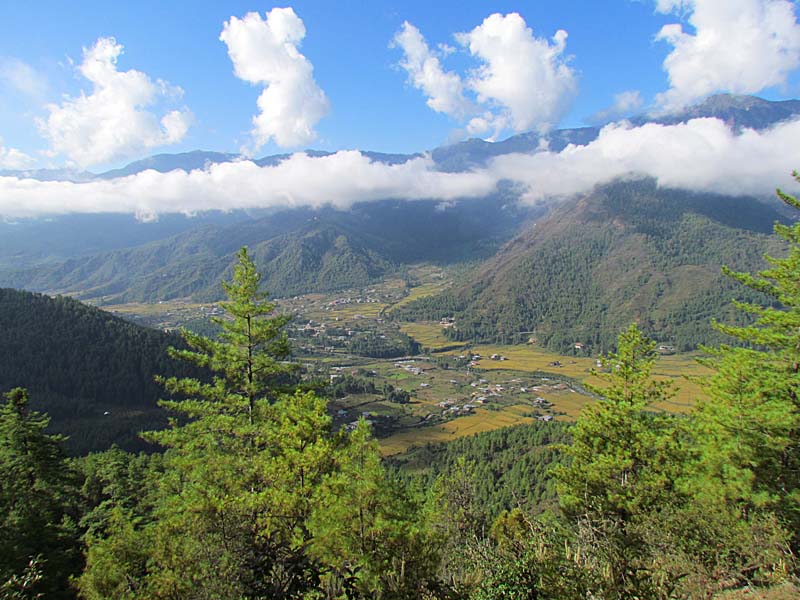
The first full day in Bhutan, we hiked up to the Tiger's Nest or Taktsang Monastery near Paro. Here is a view of the Paro valley below
as we were on the trail.
The hike itself is relatively steep. About half of the group stopped at the teahouse off the trail on the way up
and did not go all the way.
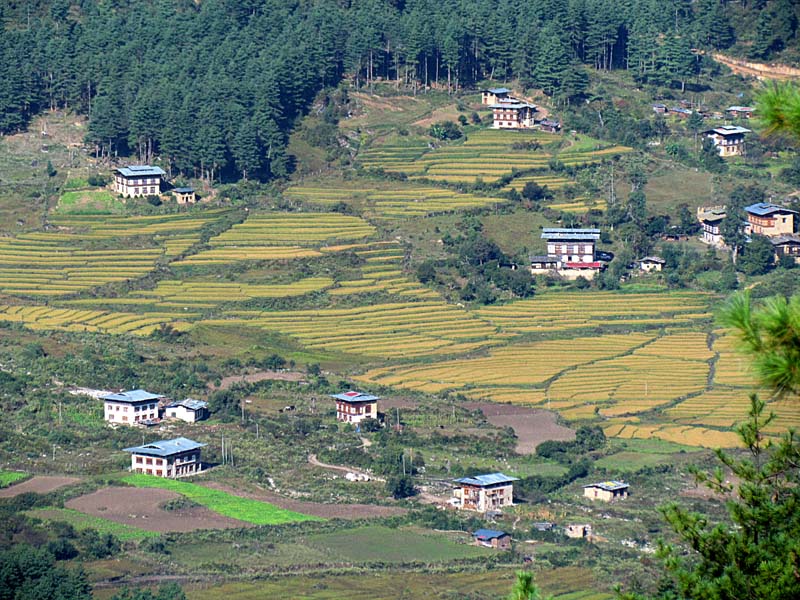
Closeup view of farm homes and rice fields. The farm homes typically include not only living quarters but also storage and livestock.
The Tantric form of Mahayana Buddhism is the official religion of Bhutan.
It is an important factor
in the development of Bhutanese society. Villages in Bhutan are filled with temples and religious structures,
which are present along the roads and trails. One can also see many prayer flags on the hills and high passes,
fluttering in the breeze. Almost every home in Bhutan has a special area called a chosum,
which is a small shrine, or a special room used for prayers. Farming is the main occupation of the people of Bhutan,
who live in small rural villages.
Most of these villages are secluded and even in the modern world, are accessible only by foot.
But some people, with the help of education, are migrating to towns in search of other occupations.
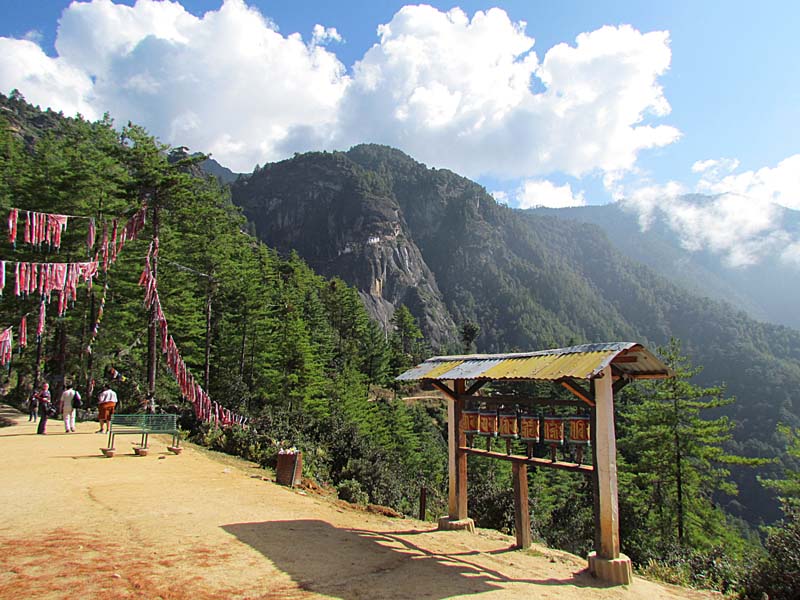
Seen on the cliff in the distance, the Taktsang monastery is the most famous Bhutanese monastery. We were close to the teahouse
at this point.
Perched on a cliff almost 3000 feet above the valley, with an elevation of 10,240 ft., the
Taktsang monastery is also known as "Tiger's Nest" because Guru Rimpoche is said to have flown there on the back of a tigress in the 8th century.
He then meditated in a cave for three months where the monastery was later built. The cave is said to be the origin of Bhuddism in Bhutan.
The monastery caught on fire in 1998 and has been largely rebuilt.
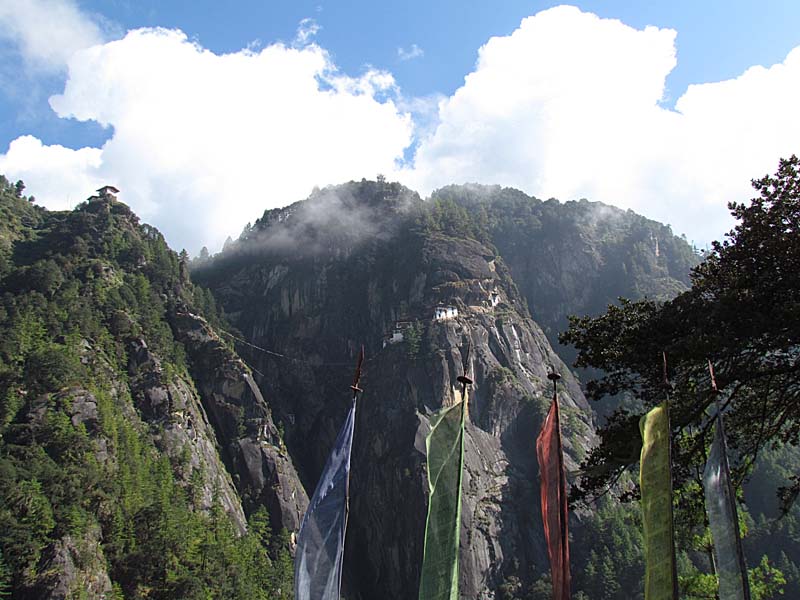
View of Tiger's Nest Monastery from the teahouse where about half of our group stopped to wait for the rest of us.
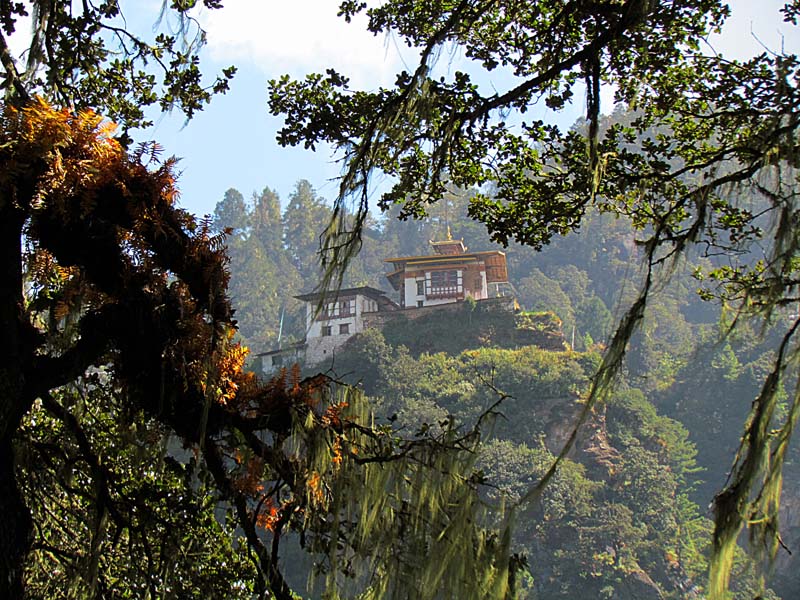
View from the trail of another part of this monastery complex.
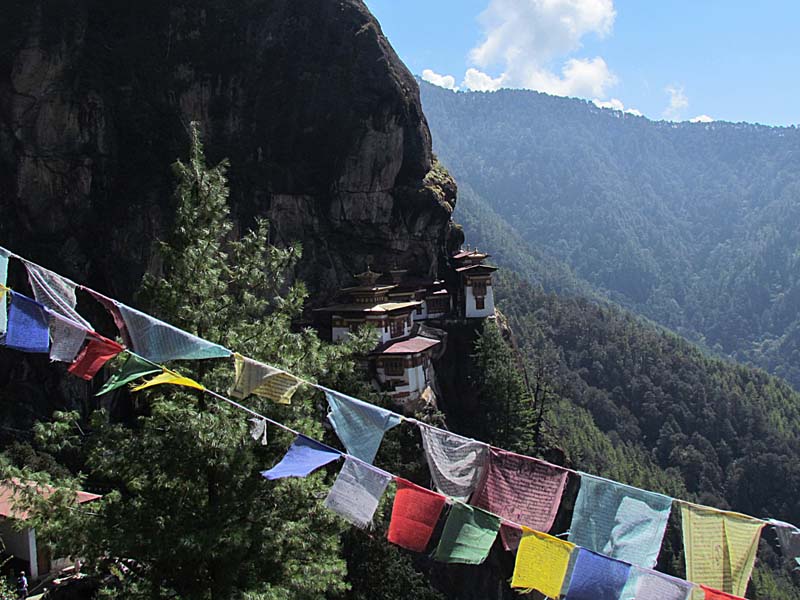
Prayer flags across the trail with the Tiger's Nest Monastery across the way and a large gully in between.
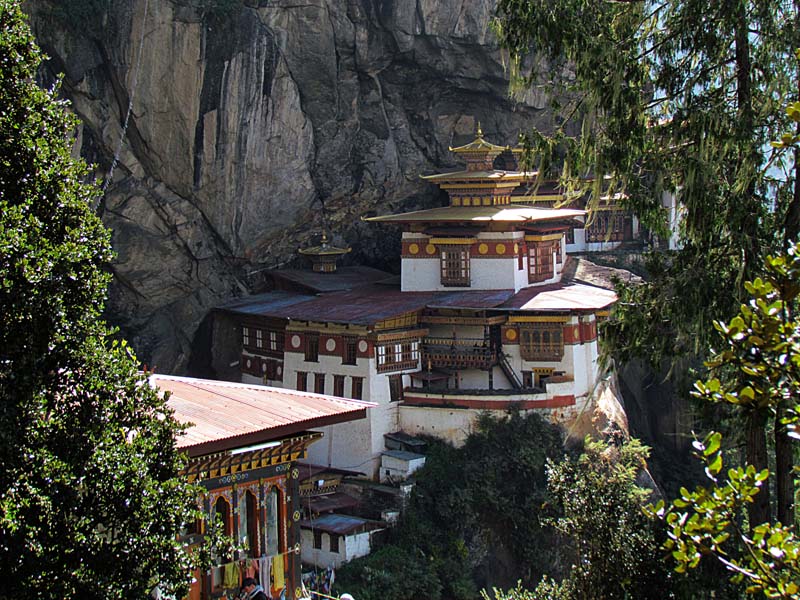
Closeup of the monastery built into the cliff. For most of the trail, you are climbing up, then you go downhill a ways to a waterfall
and climb back up to the monastery entrance.
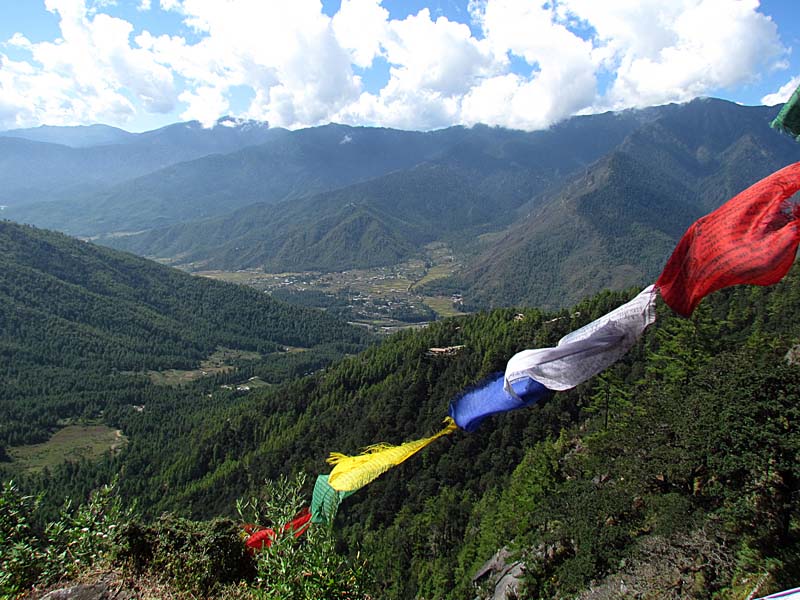
View of the Paro valley below from the trail a short distance from the monastery.
Traditionally, prayer flags are used to promote peace, compassion, strength, & wisdom. The flags do not carry prayers to gods, a common misconception;
rather, Tibetan based Buddhism believes that the prayers will be blown by the wind to spread the good will and compassion into all pervading space.
Therefore, prayer flags are thought to bring benefit to all. By hanging flags in high places the winds will carry the blessings depicted on the flags to all beings.
As wind passes over the surface of the flags which are sensitive to the slightest movement of the wind, the air is purified and sanctified.
The prayers of a flag become a permanent part of the universe as the images fade from exposure to the elements. Just as life moves on and is replaced by new life,
Buddhists renew their hopes for the world by continually mounting new flags alongside the old. This act symbolizes a welcoming of life's changes
and an acknowledgment that all beings are part of a greater ongoing cycle.
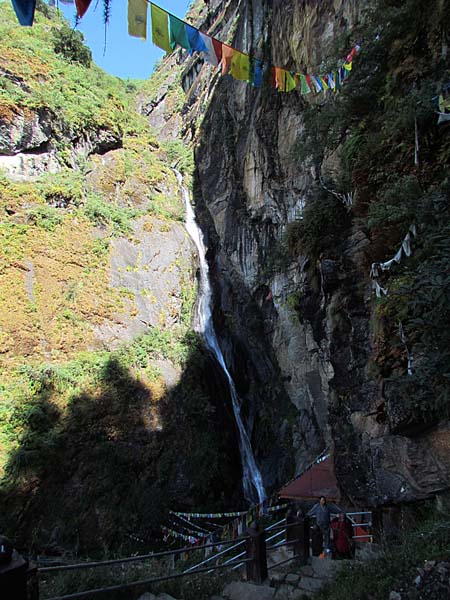
A tall waterfall close to Tiger's Nest with the steps leading up to the
entrance of Tiger's Nest in the foreground
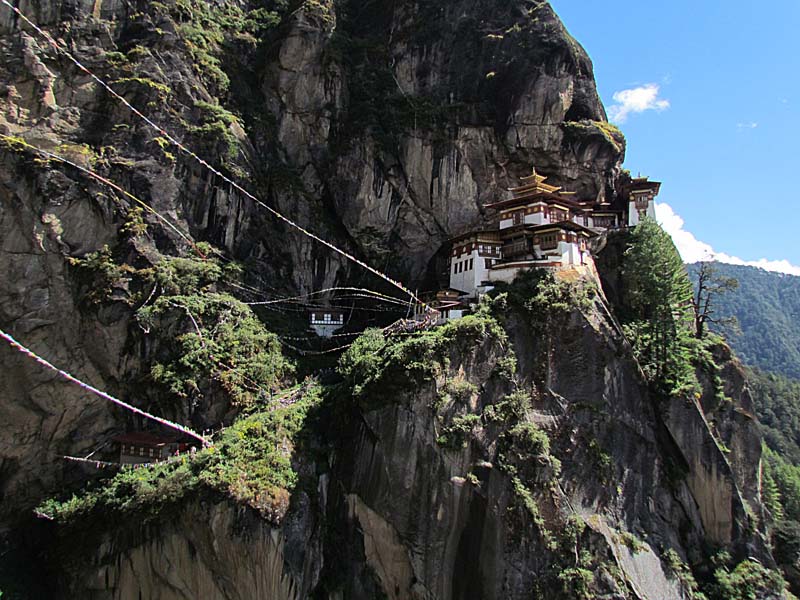
At this point, we had toured the inside of the monastery, where we were not allowed to take photos, and were heading back on the trail.
You can see in this photo how steep the cliff is where the monastery was built, then later rebuilt after fire.
We could not take
photos inside
the elaborately decorated interiors of any temple or monastery in Bhutan.The interiors are full of wall paintings, hangings, and religious
statues and offerings.
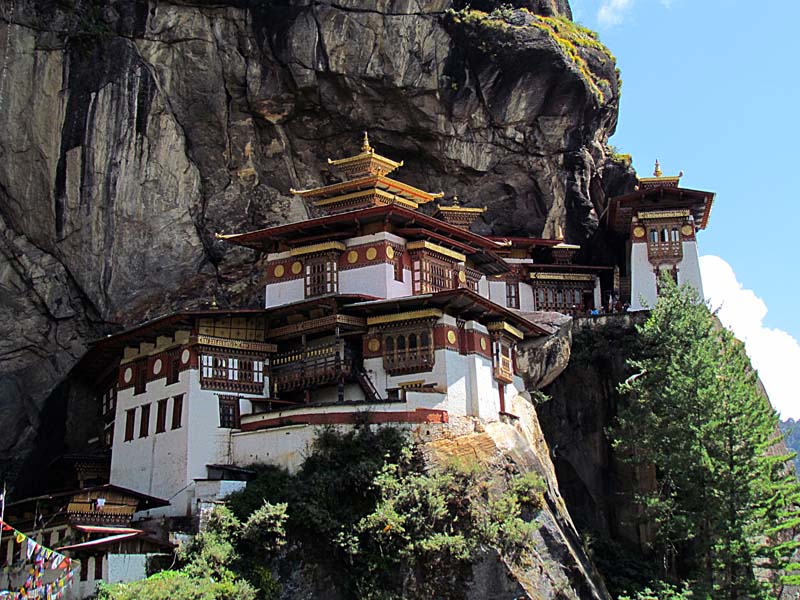
Final closeup look at Tiger's Nest as we were heading back. Most of the monasteries and temples throughout Bhutan are built
on steep hillsides and in other remote places.
This ensures that the monks get solitude and serenity.
All the monasteries
have some common features though they also have their own design.
Monasteries have a central chapel
with statues and separate sleeping quarters for the monks.
There are prayer wheels around the outside
and a round gold-coloured ornament on the roof.
Temples are not very different from monasteries in design and look;
the only difference between them is that they do not house monks.
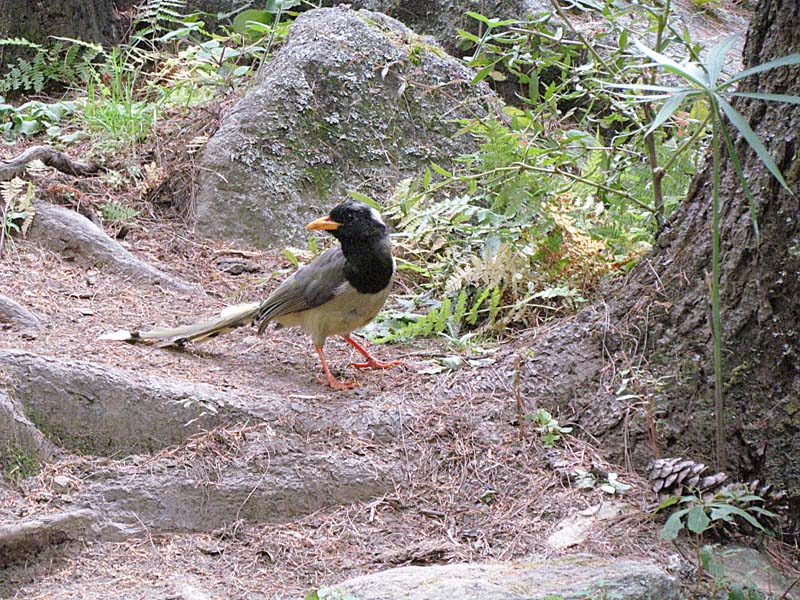
Yellow-billed magpie. These birds were all over the trees and area around the start of the trail when we returned to the trailhead.
We did not see them when we were heading up. They must have still been sleeping.
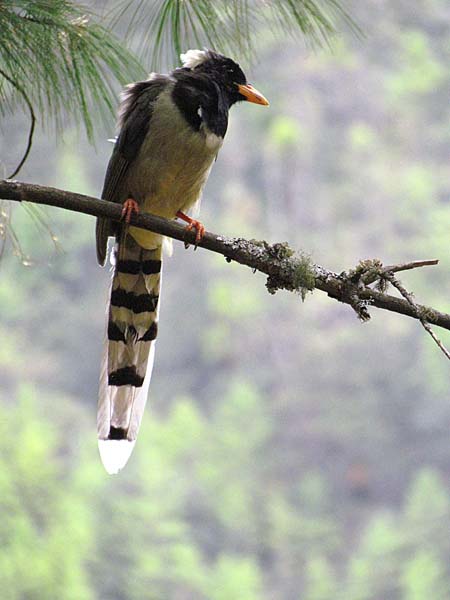
Another view of the yellow-billed magpie.
Link to Page Two - Bhutan Continued - Paro & Village Life
Pat's Home Page